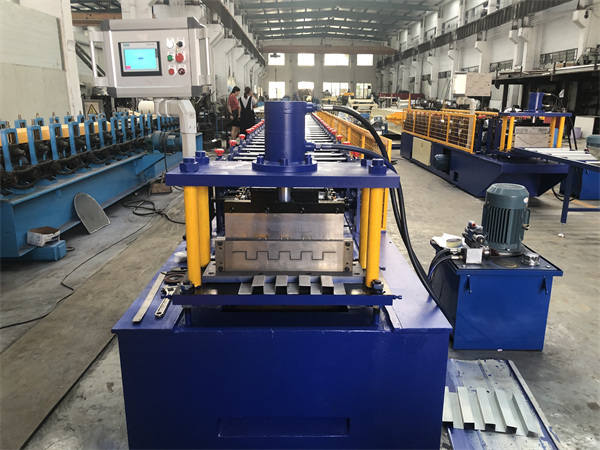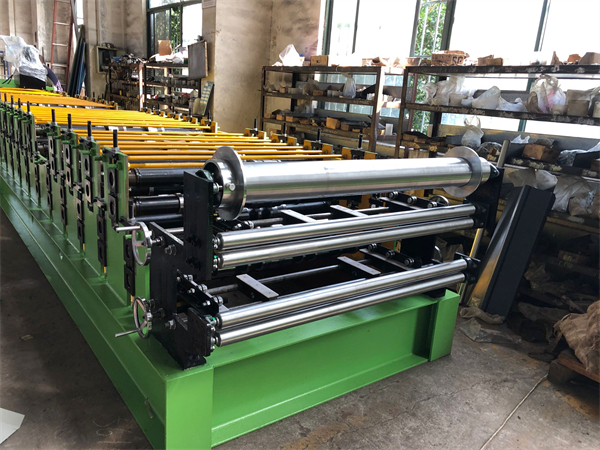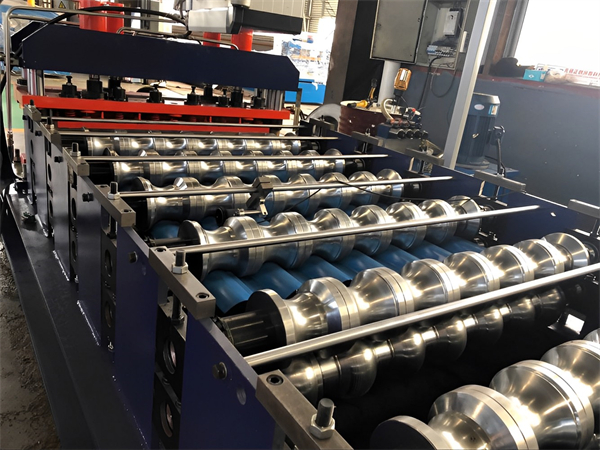Automatic roll forming machines are used to continuously bend and form metal coils into customized profiles and cross-sectional shapes. This efficient automated process is ideal for high volume production of metal parts like roofing panels, door frames, racking systems, highway railings, solar panel frames etc.
Roll formed parts have high dimensional accuracy and consistency compared to other bending methods. The flexibility of roll forming allows producing complex profiles faster and cheaper than fabrication or extrusion. This makes it popular for various applications in infrastructure, construction, automotive, agriculture, packaging, and other industries.
This guide covers everything you need to know about automatic roll forming technology – working principles, classification, major components, design considerations, specifications, applications, advantages, limitations and more.
Types of Automatic Roll Forming Machines
There are two main categories of automatic roll forming machines:
Continuous Roll Forming Machines
These produce lengthy profiles continuously from coils of sheet metal. The uncoiling, feeding, bending and cutting processes are integrated in-line for unmatched efficiency.
Step Roll Forming Machines
These operate intermittently, forming one discrete section at a time from metal strips. Each step sequentially bends the material incrementally to shape.
Continuous roll forming is significantly faster at over 100 ft/min. Step machines max out around 16 ft/min but offer more flexibility for short production runs.
| Roll Forming Machine Type | Characteristics |
|---|---|
| Continuous | High speeds up to 130 ft/min |
| Integrated in-line forming | |
| Large production volumes | |
| Step | Slower speed of 10-16 ft/min |
| Sequential bending per step | |
| Short or intermittent runs |
Classification by Structural Shape Formed
Automatic roll forming machines can be grouped based on the type of structural section produced:
- Sheet & Panel Roll Forming – For flat planar parts like roofing sheets, garage doors, trailer side walls
- Decking Roll Forming – Corrugated metal decking for floors, bridges, mezzanines
- C & U Channel Roll Forming – Cee and rectangular hollow profiles like road barriers
- Angle Roll Forming – L-shaped angle sections for shelves, racks, frames
- Hat Channel Roll Forming – Hat-shaped beams for walls, metallic studs
- Cladding Roll Forming – Architectural facade cladding, wall panels
- Door Frame Roll Forming – Hollow door and window frames
- Steel Beam Roll Forming – I-beam, H-beam
- Square/Rectangular Tube – Hollow structural sections as columns, fence posts
- Special Shapes – Custom profiles for niche applications
Classification by Industry
Automatic roll forming systems cater to a diverse range of industries:
- Construction: Wall panels, roofing, framing, windows
- Infrastructure: Highway rails, lighting poles, drainage
- Automotive: Chassis parts, panels, bumpers
- Agriculture: Silos, greenhouses, livestock pens
- Transportation: Truck bodies, trailers, railcars
- Packaging: Racks, shelving, pallets, conveyors
- Furniture: Storage, displays, frames
- HVAC: Ducting
- Appliances: Washing machines, refrigerators
This wide applicability makes roll forming a versatile metalworking process.

Key Components of Automatic Roll Forming Machines
A typical automated roll forming line consists of several modular components:
Uncoiler
The uncoiler holds a large coil of thin coiled sheet metal mounted on a shaft. It steadily unwinds the strip at the entry end.
Feeder
The feeder consists of powered pinch rollers that grip the strip and pull it through the line at a constant speed.
Pre-punching Unit
Optional pneumatic punching heads to punch holes or cutouts in the strip before forming.
Servo Electric Rollers
Rolling stations with top and bottom rollers bend the strip incrementally as it passes through. Servo motors precisely control roller movement.
Hydraulic System
Hydraulics raise/lower rollers for rapid tool-less changeovers between different profiles.
Controller
PLC controls coordinate all machine motions and track strip position.
Decoiler/Recoiler
Recoils the finished profile neatly or chops into required lengths.
Safety Enclosure
Full perimeter guarding for operator safety.
Other Options
Welding, notching, embossing, Crimping, shearing, tooling, and more between stands.
Working Principle of Roll Forming Machines
The operating principle involves continuously bending metal strip through a series of roller pairs called forming stations to gradually shape the profile:
- Sheet metal coil strip enters from uncoiler into feed unit
- Powered rollers grip and move strip forward at constant speed
- Strip passes through progressive stations that bend portion incrementally
- Top and bottom rollers rotate to impart precise bending angle
- Rollers use servo motors for adjustable pressure and position
- Control system synchronizes roller operation down the line
- Hydraulics adjust up/down for rapid tooling changeovers
- Additional operations like punching are done in-between stands
- Formed profile output to chopper or collected on recoiler
The incremental bends compound to form the final structural shape. The easy interchangability of rollers enables producing different geometries from the same machine.
Design Considerations for Roll Forming Lines
To create an optimal automated roll forming system, here are some key design factors:
Profile Shape
The desired profile geometry guides component selection. More complex shapes need more roller stations.
Metal Properties
Material grade, hardness, and thickness affect bend radius, roller loads, and line speed.
Production Volume
Higher volumes demand faster in-line continuous processes. Lower volumes suit slower step roll forming.
Strip Width
Maximum strip width depends on application. Typical range is 18 – 72 inches.
Accuracy Needed
Precision parts require servo electric rollers. Standard hydraulics suffice otherwise.
Secondary Operations
Additional punching, notching, welding needed will determine the line layout.
Safety Standards
The system must incorporate safety controls like emergency stops, guards, safe voltage.
Future Flexibility
Modular design enables easy changeovers between profiles.
Considering these parameters ensures optimal productivity from the roll forming system.
Specifications of Roll Forming Machines
Roll forming lines are highly customizable, but some typical specifications are:
| Feature | Typical Specifications |
|---|---|
| Forming Speed | 16 – 130 ft/min |
| Metal Thickness | 0.5 – 2.5 mm |
| Strip Width | 18 – 72 inches |
| Profile Width | 2 – 16 inches |
| Roller Stations | 10 – 50+ |
| Roller Diameter | 100 – 300 mm |
| Roller Type | Vertical, Horizontal, Idler, Saddle |
| Drive Method | Electric Servo, Hydraulic |
| Main Voltage | 380V, 480V 3-phase |
| Control | Siemens, Allen Bradley, Omron |
| Structure | C-frame, O-frame |
| Safety | Fully enclosed guards, safety mats |
These parameters can be customized to suit production requirements. Advanced 3D simulation software helps optimize the design.
Major Applications of Roll Formed Sections
Due to its flexibility and efficiency, automated roll forming produces a diverse range of structural parts:
Roofing and Siding
- Corrugated and standing seam metal roof/wall panels
- Trapezoidal roof sheeting
- Insulated architectural panels
Framework and Framing
- C/U channel frames for mezzanines, racks, platforms
- Hollow metal door jambs and frames
- Steel studs for interior walls, partitions
Highway Safety Products
- W-beam crash barriers
- Highway guard rails
- Light pole standards
- Traffic sign posts
Agricultural Buildings
- I-beam rafters
- U-channel sections for livestock pens
- Silo rings
- Greenhouse frames
Automotive Components
- Inner panel reinforcements
- Bumpers, side rails
- Chassis frames
- Wheel rims
HVAC Ducting
- Spiral rectangular ducts
- Round/oval ducts
- Ventilation shafts
These profiles optimize strength-to-weight ratio and are fast to produce.

Benefits of Roll Formed Sections
Here are some of the advantages of using roll formed parts instead of alternate methods:
High Production Rates
- Up to 10x faster than extrusion
- Outpaces fabrication speeds
- Ideal for high volume continuous runs
Dimensional Consistency
- Maintains precise tolerances
- Same accuracy along the length
- Less warped or deformed parts
Design Flexibility
- Make endless cross-sectional shapes
- Easily adjust profiles
- Suit small batch custom jobs
Material Savings
- No wasted offcuts like fabrication
- Uses thin coiled steel efficiently
- Lower costs than extruded shapes
Strength Properties
- Cold forming work-hardens the metal
- Increases strength up to 25%
- Lightweight but rigid parts
Superior Finish
- Smooth, uniform surface texture
- No welding or machining marks
- Consistent appearance
Lower Tooling Costs
- Only rollers need changing
- Faster changeovers than presses
- Scalable incremental tooling
Minimal Secondary Processing
- Finished parts off the line
- Little extra drilling, welding
- Saves additional steps
These factors make roll forming the process of choice for producing straight metal sections in long lengths.
Limitations of Roll Forming Technology
However, there are some limitations to be aware of when designing roll formed components:
- Part Lengths – Limited to width of coils, max 60-100 ft lengths
- Profile Height – Max height restricted to 5 inches
- Bend Radius – Radii under 2x thickness risks cracking
- Width Capability – Max strip width around 72 inches
- Geometric Complexity – Simpler profiles preferred
- Strength – Weaker than comparable extrusions
- Appearance – Surface marks from rollers
- Fixed Tooling – Making new shapes requires full tooling change
- Batch Sizes – Short runs under 1000 pcs inefficient
Engineers must work within these boundaries during design. Roll forming remains ideal for long production runs of basic sections within the process capabilities.
How to Choose a Roll Forming Machine Supplier
Selecting the right roll forming machinery partner is critical to operational success. Here are important factors to evaluate potential suppliers on:
Experience
- Years in business and number of projects executed
- Knowledgeable about the latest innovations
Production Capabilities
- Offer range of machine sizes and production volumes
- Advanced servo-electric and hydraulic technology
- Forming speeds to meet demands
Flexibility
- Quick changeovers between profiles
- Modular expandable designs
- Custom engineering services
Reliability
- Reputable vendors and components
- Stringent quality control and testing
- Robust heavy-duty construction
Automation
- Advanced software and controls
- Smart diagnostics and monitoring
- Integrated safety features
Service Support
- Local presence for prompt maintenance
- Operator training programs
- Long-term spare parts availability
Cost
- Competitive pricing on equipment
- Value engineering for most efficient solution
Partnering with an established roll forming OEM with proven expertise and global support capabilities ensures a successful project.
Roll Forming Machine Pricing
Roll forming equipment represents a major capital investment. Prices vary based on:
Production Volume
- Higher volume continuous lines are more expensive
- Entry level step roll formers start around $50,000
Size
- Costs increase with width and speed capabilities
- Typical range from $75,000 to $500,000
Geometry Complexity
- Simpler C/U channels lower cost than specialty profiles
- More tooling stations also increases cost
Automation
- Servo electric better than hydraulic drives
- Advanced software and controls add cost
Accessories
- Secondary punching/cutting units
- Custom conveyors, coilers etc.
Freight & Installation
- Shipping heavier machines from overseas
- Installation services extra
Purchasing complete turnkey systems from reputable suppliers ensures optimal performance and service. Request custom quotations based on production needs.
Choosing Between Roll Forming and Extrusion
Roll forming and aluminum extrusion are two common methods for making long straight metal sections. Here is a comparison between roll forming and extrusion processes:
| Criteria | Roll Forming | Extrusion |
|---|---|---|
| Capital Cost | $$ – $$$ | $$$$$$ |
| Running Cost | $-$$ | $$$ |
| Speed | High, 100 ft/min+ | Slower, 50 ft/min max |
| Metals Used | Steel, aluminum | Aluminum only |
| Strength | Medium-High | Very high |
| Lengths | Up to 100 ft | Up to 50 ft max |
| Shapes | Simple and complex | Complex shapes only |
| Tolerances | Excellent, ISO | Very good |
| Surface Finish | Smooth with roller marks | Excellent |
| Changeovers | Quick roller changes | Slow die changes |
| Volume Flexibility | Good, from 100pcs | Poor, over 10,000 pcs |
| Secondary Ops | Shearing, punching | Fabrication required |
| Typical Applications | Construction, auto, HVAC | Transport, marine, aerospace |
In summary, roll forming is more economical for long production runs of steel profiles, while aluminum extrusion better suits small batches of complex shapes.
Pros and Cons of Roll Forming vs Press Brake Bending
Press brakes and roll forming both bend sheet metal, but have distinct advantages and disadvantages:
| Method | Advantages | Disadvantages |
|---|---|---|
| Roll Forming | Very fast continuous process | Only linear bends possible |
| Highly repeatable precision | Limited profile shapes | |
| No tooling mark-off on part | Dedicated tooling for profiles | |
| Lower tooling cost than dies | Parts must be cut to length | |
| Easy to automate | Max height under 6 inches | |
| Well-suited for volume production | ||
| Press Brake Bending | Versatile – make any bend shape | Slower than roll forming |
| No limit on part dimensions | More tooling mark-off | |
| Smaller batches economic | Less repeatability | |
| Simple tool changeovers | Difficult to automate | |
| Ideal for custom one-off parts |
In short, roll forming excels at long production runs while press brakes are better for short-run custom work.
Maintenance Tips for Roll Forming Machines
To maximize productivity of roll forming lines and reduce downtime, here are some key maintenance practices:
Daily:
- Clean metal debris and dust off all parts
- Check hydraulic fluid levels
- Lubricate roller bearings
- Inspect safety guards and stops
- Verify electrical, hydraulic connections
Weekly:
- Check belt tension and gearbox oil
- Inspect roller surface wear
- Test emergency stop buttons
- Verify strip alignment in rolls
Monthly:
- Check chain/sprocket wear on conveyors
- Inspect rollers for uneven wear or damage
- Verify pneumatic system pressure
- Test correct operation of all sensors
- Check drive motor currents for imbalance
Quarterly:
- Thorough inspection of all safety mechanisms
- Check roll cylindrical tolerances
- Inspect shafts, keys, fasteners for wear
- Verify PLC program and backups
- Confirm alignment of roll stands
Proper preventative maintenance minimizes unplanned downtime and enhances productivity.

Roll Forming Safety Tips
Working safely around roll forming equipment is critical. Here are some key safety guidelines:
- Restrict access for only trained operators
- Require personnel to wear cut-resistant gloves
- Ensure adequate emergency stop buttons
- Keep electrical panels locked with safety interlocks
- Never bypass or disable safety guards or mats
- Stop machinery before any tooling adjustments
- Follow lockout/tagout procedures for maintenance
- Watch out for sharp edge hazards from metal strips
- Keep body parts away from rotating rollers
- Clean up any oil leaks immediately to prevent slips
- Never climb on the equipment while running
- Verify sufficient lighting in production area
Incorporating these safety practices and training creates a secure operational environment.
Frequently Asked Questions About Roll Forming
What is roll forming used for?
Roll forming is used to make long, straight metal structural sections like roofing panels, door frames, barrier rails, highway signs, and solar panel frames.
How does a roll forming machine work?
It works by continuously bending a strip of sheet metal through a series of roller stations. Each station incrementally forms the shape of the profile.
What metals can be roll formed?
Common roll formed metals include low carbon steel, stainless steel, and aluminum. Softer metals like copper or brass can also be roll formed.
What shapes can be roll formed?
Simple long profiles like C and U channels, tubes, rails, bars, studs, beams and corrugated sheets. Complex asymmetric custom shapes are possible too.
How long can a roll formed part be?
Standard lengths are up to 60 feet, but some machinesCopy can produce parts up to 100 feet long depending on the coil strip width.
What is the difference between roll forming and press brakes?
Roll forming is a continuous process using a series of roller stations to incrementally form shapes. Press brakes make custom bends by applying focused pressure with a die.
How does roll forming compare to metal extrusion?
Roll forming is cheaper, faster and uses steel. Extrusion makes complex profiles from aluminum but has higher tooling costs.
What tolerances can roll forming hold?
Roll formed parts can reliably achieve dimensional tolerances of +/- 0.5 mm. Some machines can hold +/- 0.3 mm.
